In September 2021, No-Till Farmer commissioned a project to determine the most significant research and publications that assisted in the understanding and adoption of no-till agriculture. Randall Reeder, retired ag engineer from Ohio State Univ., and Don Reicosky, retired USDA soil scientist, collaborated on a detailed process to complete this large and aggressive project in advance of three important no-till milestones in 2022.
Solicitations of the scientific community worldwide yielded 208 nominated works for consideration as the most significant for North American No-Tillage and for Global Conservation Agriculture (as the system is more widely known internationally). From that list of 208 works, volunteer subcommittees provided their rankings and feedback to Reeder (North America) and Reicosky (Global) in mid-November.
“Knowledge not shared is knowledge wasted…”
– Saidi Mkomwa, African Conservation Tillage Network, South Africa
What follows are the Top 15 North American No-Tillage Works and Top 15 Global Conservation Agriculture Works, arranged by the primary author’s last name. The format and process established in 2021 will serve as a framework in subsequent years to recognize additional important works, which also include the citations and in some cases, the complete works.
No-Till Farmer wishes to express its gratitude to Randall and Don for their exhaustive yet challenging task of selecting the most significant works in no-till history, and building a framework for future reviews.
– Mike Lessiter, No-Till Farmer,
December 10, 2021.
[Podcast] Great No-Till Research with Don Reicosky and Randall Reeder
In this episode of the No-Till Farmer Influencers & Innovators podcast, Frank Lessiter talks with Randall Reeder, retired ag engineer from Ohio State University and Don Reicosky, retired USDA soil scientist about their collaborated on the detailed process to complete the large and aggressive project in advance of three important no-till milestones in 2022.
Top 15 Most Significant No-Till Research Works: North America
By Randall Reeder
North American No-Till Farmer Research List
Project Chair
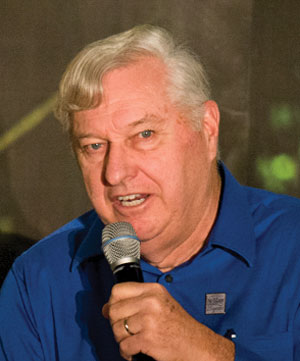
Stubble Over the Soil: The Vital Role of Plant Residue in Soil Management to Improve Soil Quality
by Carlos Crovetto, 1996.
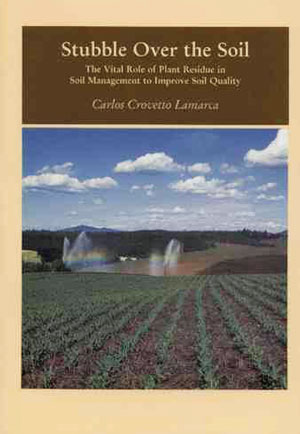
Stubble Over the Soil (1996)
This book, published by the American Society of Agronomy, describes the management of highly degraded soils in Chile. Five chapters discuss conservation for production, management of a no-tillage system, factors limiting and favoring no-tillage production, the effect of no-tillage on natural soil parameters, and aspects of productivity and profitability.
Citation: Crovetto, C. “Stubble Over the Soil: The vital role of plant residue in soil management to improve soil quality.” American Society of Agronomy, Inc, Madison, WI, 1996.
Continuous Tillage and Rotation Combinations Effects on Corn, Soybean, and Oat Yields
by Warren A. Dick and David M. Van Doren Jr., 1985.
This Ohio paper published crop yields after 20-plus years of continuous no-till on the same plots on two soil types since 1962. It contrasted with many no-till experiments conducted for only a few years on a single soil type. A prevailing theory at the time was that soils must be plowed every few years to mix nutrients throughout the root zone and bury disease organisms.
However, on the well-drained Wooster soil, no-till yielded better than plow tillage in most years, an advantage that did not wane over time. The heavier clay Hoytville soil did not respond in the same way. More research would be needed on poorly drained clay soils to take advantage of the many no-till benefits.
Citation: Dick, W.A. and Van Doren, D.M., Jr. “Continuous Tillage and Rotation Combinations Effects on Corn, Soybean, and Oat Yields.” Agron. J., 1985, 77:459-465.
Plowman’s Folly
by Edward H. Faulkner, 1943.
“The fact is that no one has ever advanced a scientific reason for plowing.” That key sentence opened a new era in farming. Conventional thinking about the management of the soil rested upon the use of the moldboard plow. Faulkner proved conclusively that soil impoverishment, erosion, decreasing crop yields and many of the adverse effects of droughts and excessive rainfall could be traced to plowing.
This book is recognized as the most important challenge to agricultural orthodoxy in the 1900s. Its new philosophy of the soil, based on proven principles, had a strong impact upon theories of cultivation around the world. Through experiments on his own Ohio farm, the former “county extension agent” transformed inferior soils into productive, high-yield croplands.
(See more on Faulkner’s work.)
Citation: Faulkner, Edward H. “Plowman's Folly.” Grosset & Dunlap Publishers New York, University of Oklahoma Press, 1943.
Effect of Eight Tillage-Planting Systems on Soil Temperature, Percent Stand, Plant Growth and Yield of Corn on Five Indiana Soils
by Don R. Griffith, Jerry V. Mannering, H.M. Galloway, Sam D. Parsons and C.B. Richey, 1973.
In the mid-1960s, farmers considered no-till to cut production costs. Environmentalists saw it as means of reducing erosion. This research evaluated where no-plow tillage methods could be adapted in the Corn Belt. The objective of this research was to determine the corn production potential of 8 tillage systems, including chisel, strip rotary and strip coulter. They were compared with conventional and limited tillage for 4 years.
Results indicated that with good management, chisel, till, strip, rotary and coulter systems are adapted on the rolling high-silt soils of southern Indiana and on well-drained loam or sandy loam soils in central and northern Indiana. The no-plow systems, as used in these tests, were not adapted on poorly drained, fine-textured soils.
Citation: Griffith, D.R., Mannering, J.V., Galloway, H.M., Parsons, S.D., and Richey, C.B. “Effect of Eight Tillage-Planting Systems on Soil Temperature, Percent Stand, Plant Growth and Yield of Corn on Five Indiana Soils.” Agron. J., 1973, 65:321-326.
Long-Term Tillage and Rotation Effects on Corn Growth and Yield on High and Low Organic Matter, Poorly Drained Soils
by Don R. Griffith, Eileen J. Kladivko, Jerry V. Mannering, T.D. West and Sam D. Parsons, 1988.
This Indiana research relates corn growth and yield for several reduced tillage systems used with continuous corn and a corn-soybean rotation on Chalmers silty clay loam (12 years) and Clermont silt loam (7 years). Tillage systems included moldboard plowing, chisel plowing, ridge planting and no-till planting. On the high-organic matter Chalmers soil, continuous no-till corn had 9% lower yields compared to plowing. Following soybeans, no-till corn yielded 2.6% lower.
On the low-organic matter soil in continuous no-till corn, yields were lower the first 3 years, but equal or better than plowed for the final 4 years. In rotation, no-till corn was equal to plowed the first 3 years and significantly better in 3 of the last 4 years.
Citation: Griffith, D.R., Kladivko, E.J., Mannering, J.V., West, T.D., and Parsons, S.D. “Long-Term Tillage and Rotation Effects on Corn Growth and Yield on High and Low Organic Matter, Poorly Drained Soils.” Agron. J., 1988, 80:599-605.
Severe Rainstorm Test of No-Till Corn
by Lloyd L. Harrold and William M. Edwards, 1972.
A continuous no-till corn watershed on a steep (21%) slope was hit with 5.5 inches of rain in 7 hours on July 5, 1969. Almost half of the rain (2.5 inches) ran off. How much sediment would you guess left the field?
Sediment yield was 63 pounds per acre. Yes, 63 pounds. A comparison watershed, a 6.6% slope with corn in plowed ground, had 4.4 inches of runoff and lost 22 tons per acre of sediment. This research at the USDA-ARS Northern Appalachian Experimental Watershed in Coshocton, Ohio, continued for 40 years. Later articles showed that a total of only 6 rainfall events in 40 years resulted in any lost sediment on that no-till watershed.
Citation: Harrold, L.L., and Edwards, W.M. “Severe Rainstorm Test of No-Till Corn.” J. Soil Water Conserv., 1972, 27:30.
No-Till: The Quiet Revolution
by D.R. Huggins and J.P. Reganold, 2008.
This article, written in lay terms, is based in the hilly but productive Palouse Region of Southeast Washington. By the late 1970s, soil erosion in the Palouse had removed 25-75% of the topsoil from 60% of the land. Runoff carried sediment, fertilizers and pesticides into roadside ditches, rivers, lakes and oceans.
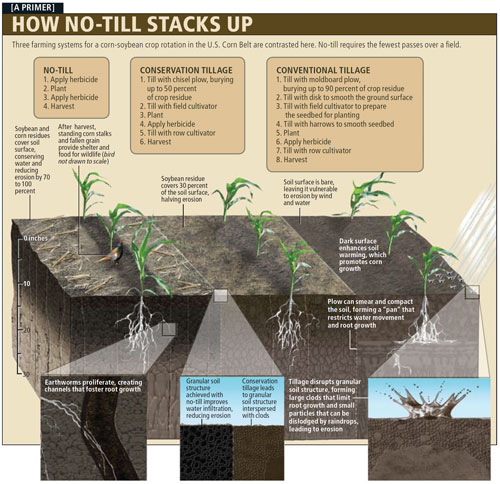
No-Till: The Quiet Revolution (2008) (Scientific American 2008)
No-till farming minimized soil disruption. In 1974, one young farmer, John Aeschliman of Colfax, Wash., decided to experiment with no-till farming. Thirty-four years later, the black earth on his family’s 4,000 acres has a porous structure, an abundance of organic matter that facilitates root growth and loads of earthworms, too. As agriculture expands to feed a growing world population, protecting our precious soil and the environment are essential.
Citation: Huggins, D. R., and Reganold, J. P. 2008. “No-Till: The Quiet Revolution.” Scientific American, 2008, 299 (1), 70-77.
Evolution of the Plow over 10,000 Years and the Rationale for No-Till Farming
by Rattan Lal, Don C. Reicosky and J.D. Hanson, 2007.
Agriculture and the plow originated 10-13 millennia ago in the Fertile Crescent of the Near East and were introduced into southeastern Europe about 8,000 years ago. The wooden plow evolved into the iron “Roman plow” around 1 A.D., then into a soil-inverting plow during the 8th to 10th centuries. In the U.S., Thomas Jefferson designed a moldboard plow in 1784. In the 1830s, an Illinois blacksmith, John Deere, added a steel sheet over a cast iron plow.
Steam tractors in the early 1900s led to widespread plowing, resulting in soil erosion and the Dust Bowl. Development of 2,4-D after World War II allowed a transition to conservation tillage and successful no-till with crop residue left on the surface.
Citation: Lal, R., Reicosky, D.C., and Hanson, J.D. “Evolution of the Plow over 10,000 Years and the Rationale for No-Till Farming.” Soil & Tillage Research, 2007, 93, 1-12.
Conquest of the Land Through 7,000 Years
by Walter C. Lowdermilk, 1953.
Agriculture had its beginnings at least 7,000 years ago and developed in the fertile alluvial plains of Mesopotamia and the Nile Valley. In an arid climate, tillers of soil began to grow food crops by irrigation. Canals were dug, but it took a labor force to keep them clean of silt that eroded from hillsides upstream. Soil washed off the slopes to bedrock. It was no longer a land of milk and honey.
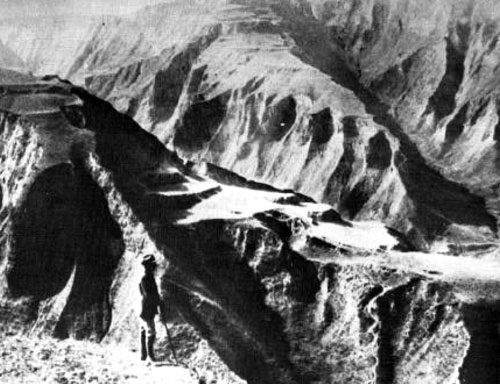
SEVERE EROSION. These huge gullies indicate the severity of soil erosion in the deep, and once fertile loessial soils of northern China. Millions of acres have been cut up like this and are now almost worthless. (Lowdermilk’s Conquest of the Land Through 7,000 Years).
With 3 to 6 feet of soil gone, cities died. Similar destruction occurred in China and North Africa as forests were cleared, land was cultivated and soil eroded away. Lowdermilk toured this region for the USDA during 1938-39. This article serves as a warning about North America’s land, farmed for less than 300 years.
Citation: Lowdermilk, W.C. “Conquest of the Land Through 7,000 Years.” Agric. Inf. Bull. 99. USDA-SCS, US Government Printing Office, Washington, DC., 1953. Reprinted 1986.
Dirt: The Erosion of Civilizations
by David R. Montgomery, 2007.
This book provides a history of soil from ancient civilizations to modern times. Simply stated, we are using up Earth’s soil. Cultivated soils often erode slowly, but over centuries, the loss of productive soil limits or wipes out civilizations.
Dirt traces the role of soil use and abuse in the history of Mesopotamia, ancient Greece, the Roman empire, China and others up through the American push westward (Dust Bowl). Societies have risen, prospered and plowed through a natural endowment of fertile topsoil. Montgomery sees the move to no-till farming and conservation agriculture as a hopeful future that might help us avoid the fate of earlier civilizations.
Citation: Montgomery, D. R. “Dirt: The Erosion of Civilizations.” Berkeley: University of California Press, 2007, 295 p.
No-Tillage Farming
by Shirley Phillips and Harry Young, 1973.
This book was the first of its kind in the world, spreading the knowledge of — and interest in — no-tillage farming and stimulating more research and on-farm testing.
The first three chapters give a historical account, describe a no-till demonstration on the Young farm in Kentucky and explain the advantages and disadvantages of no-till. The remaining chapters address air and water pollution, soil types, crops and crop rotations, future developments, economics, machinery, fertilizer application, sowing, weed/sod control and pest control.
The different minimum tillage systems and their advantages and disadvantages are discussed. Pollution reduction, soil problems, economics, machinery and sowing, fertilizer application and the control of pests and weeds are also covered.
Citation: Phillips, Shirley and Young, Harry. “No-Tillage Farming.” Reiman Assoc./No-Till Farmer, Milwaukee, Wis, 1973.
Conservation Tillage Systems and Management
edited by Randall C. Reeder, 1992 and 2000.
The two editions, which cover crop residue management with no-till, ridge-till, mulch-till and strip-till, sold the most copies in the history of the Midwest Plan Service. The 1992 edition has 22 chapters written by 50 authors. The 2000 edition has 29 chapters by 57 authors. The books aimed to help farmers learn and adopt best practices. Among the topics are erosion; economics; water quality; soil compaction; cover crops; managing nutrients, weeds, insects and disease; equipment for seeding; and site-specific crop management.
Citation: Reeder, Randall C., Technical Editor. “Conservation Tillage Systems and Management.” MWPS-45. 1st ed., Iowa State University, Ames, IA, 1992, pp.140. 2nd ed., 2000, pp.270.
Fall Tillage Method: Effect on Short-Term Carbon Dioxide Flux from Soil
by Don C. Reicosky and M.J. Lindstrom, 1993.
This work determines the effect of four fall tillage methods (moldboard plow, plow plus disk twice, disk once and chisel plow) vs. no-till on short-term CO2 flux from a clay loam at Morris, Minn.
Measurements of CO2 flux were started within 5 minutes of tillage and continued intermittently for 19 days. The moldboard plow had the highest flux. High initial flux rates were related to depth of soil disturbance that resulted in rougher surfaces and larger voids. Lower flux rates resulted from less soil disturbance and small voids. The differences suggest that improved soil management can minimize agriculture’s impact on global CO2 increase.
Citation: Reicosky, D.C., Lindstrom, M.J. “Fall Tillage Method: Effect on Short-Term Carbon Dioxide Flux from Soil.” Agron. J., 1993, 85(6):1237–1243.
Agriculture Without Tillage
by Glover B. Triplett Jr. and David M. Van Doren Jr., 1977.
This paper, written in lay terms, reviewed the existing practices for growing corn in the Midwest and why these practices became firmly entrenched.
“One naturally wonders why anyone would even think of eliminating or reducing such firmly established practices. The reason is that under the right conditions, the elimination or reduction of tillage can make farming easier and more profitable.”
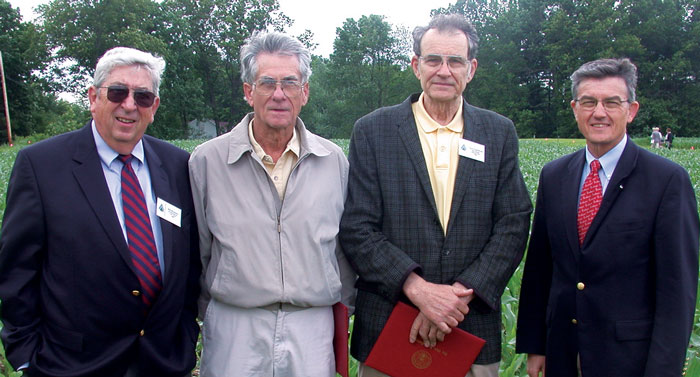
NO-TILL NOTABLES. Ohio State University renamed its no-till research plots after its two prominent no-till researchers and authors Glover Triplett and the late Dave Van Doren. From left are OSU alum and retired NRCS Chief Bill Richards, Triplett, Van Doren and Bobby Moser, OSU Ag College Dean.
The paper describes ways to mitigate limitations to adopting no-tillage (weed control, crop stand establishment, crop rotation, tillage interactions and crop residue issues). It contributed much to overcoming the concerns of researchers and growers about no-tillage. It spurred many experiments, which led to the practices and products that have made no-till the dominant system in many parts of the world.
Citation: Triplett, Glover B. Jr., and Van Doren, David M. Jr. “Agriculture Without Tillage.” Scientific American, Vol. 236, No. 1., January 1977. pp. 28-33.
Conservation Tillage Systems
by Paul W. Unger and T.M. McCalla, 1980.
This article was published in the early days of no-till and explained different conservation tillage systems and their three main goals: Always leave enough plant residue on the soil surface for water and wind erosion control, reduce energy use, and conserve soil and water. These systems can be applied to all kinds of crop residue in many cropping systems.
Because conservation tillage systems rely heavily on surface residue for erosion control and water conservation, it is imperative that planters and drills operate well when large amounts of residue are on the soil surface. Equipment developed recently for conservation tillage can retain most crop residue on the soil surface.
Citation: Unger, P.W., and McCalla, T.M. “Conservation Tillage Systems.” Advances in Agronomy, 1980, Vol: 33: 1-53.
Top 15 Most Significant Conservation Ag (CA) Research Works: Global
Don Reicosky
Global No-Till Farmer Conservation Ag Research List Project Chair
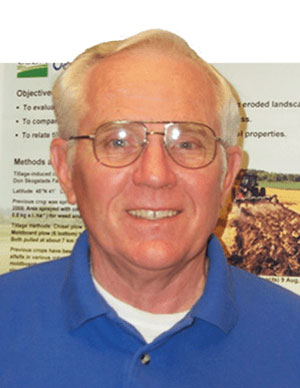
The Economic, Agronomic and Environmental Impact of No-Till on the Canadian Prairies
by M.N. Baig and P. Gamache, 2011.
The authors describe no-tillage or zero-till farming systems popular in the U.S. and Canadian prairies because they improve the physical, chemical and biological properties of the soil, and provide substantial savings. Benefits include planting a crop into the untilled stubble of a previous crop with little or no soil disturbance as a critical conservation practice, with savings on fuel, machinery life and labor, while maintaining or improving crop yields.
The authors also note the practices as environmentally friendly with increased soil-organic matter, improved soil tilth, improved water conservation, storage/use efficiency and reduced soil erosion. No-till seeding also has the potential to store atmospheric carbon important in the mitigation of greenhouse gas emissions.
Citation:Baig, M.N. and P. Gamache. 2011. The Economic, Agronomic and Environmental Impact of No-Till on the Canadian Prairies. Alberta Reduced Tillage Linkages. Version 2: 176 pages.
No-Tillage Seeding in Conservation Agriculture
by C.J. Baker and K.E. Saxton, 2007.
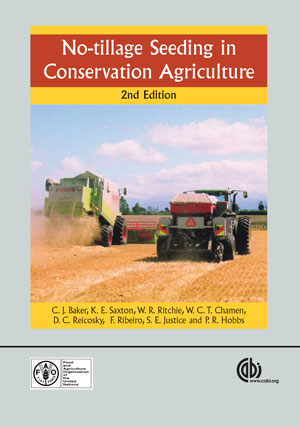
No-Tillage Seeding in Conservation Agriculture (2007)
This book is a much-expanded and updated edition of a previous volume, published in 1996 as No-Tillage Seeding: Science and Practice that was the first of its kind. The primary objective was to describe, in lay terms, a range of international experiments designed to examine the causes of the successes and failures in no-till. The authors describe and analyze no-till technologies, particularly those related to no-till seed drilling, from a variety of accumulative experiences over the previous 40 years.
Collectively, the authors provide a comprehensive overview of a successful no-till enterprise that includes machinery design and operating principles for minimum soil disturbance. The book highlights the pros and cons of a range of features and options, without promoting any particular product, and provide a comparative performance record of several different machine design options and management practices, tested under controlled conditions and how these have been found to integrate into a whole no-till system.
Citation: Baker, C.J. and K.E. Saxton (Eds). 2007. No-tillage Seeding in Conservation Agriculture. 2nd Edition. Food and Agriculture Organization of the United Nations, Rome and CAB International, UK. ISBN: 1-84593-116-5. 326 pages.
No-Tillage in Europe – State of the Art: Constraints and Perspectives
by G. Basch, J. Geraghty, B. Streit and W.G. Sturny, 2008.
State-of-the-art no-till adoption in Europe is described in this brief review of agricultural developments over the last three decades. The authors discuss the evolution of no-till with emphasis on developing comprehensive system concepts. Much of Europe has been dependent on intensive tillage, especially the moldboard plow. Reasons for attempts to introduce no-till as a soil-conserving production method are outlined, as are the obstacles affecting the widespread uptake of no-till throughout Europe. Contemporary data is provided for the adoption of both conservation and no-till in the member countries of the European Conservation Agriculture Federation (ECAF) that facilitate farmer networking and mentoring.
Citation: Basch, G., Geraghty, J., Streit, B., and Sturny, W. G. (2008). No-tillage in Europe–state of the art: constraints and perspective. In: No-Till Farming Systems, pp. 159-168. Eds. T. Goddard, M. A. Zoebisch, Y. T. Gan, W. Ellis, A. Watson, S. Sombatpanit. World Association of Soil and Water Conservation, Special Publication No. 3, Bangkok: WASWC.
Combined Role of No-Tillage and Cropping Systems in Soil Carbon Stocks and Stabilization
by P.C. Conceição, J. Dieckow and C. Bayer, 2013.
The importance of no-till and diverse cropping in conservation ag systems on soil C stocks was clearly demonstrated by these authors in Brazil. Their early recognition of the limiting impacts of intensive tillage on soil carbon management, soil functions and ecosystem services have benefited farmers worldwide. Their observation of the importance of different cover crop species provides insights that are now highlighting the importance of biodiversity in our agricultural production systems. Annual C storage rate in no-till treatment was attributed to the higher biomass-C addition and inclusion of legume cover crops. Most of the C accumulation relative to conventional tillage occurred in the mineral-associated fraction, showing the importance of organo-mineral interaction in C stabilization, demonstrating no-till as a sustainable soil management practice for soil C accumulation.
Citation: Conceição, P. C., Dieckow, J., and Bayer, C. (2013). Combined role of no-tillage and cropping systems in soil carbon stocks and stabilization. Soil Till. Res. 129, 40–47. doi: 10.1016/j.still.2013.01.006
The Transformation of Agriculture in Brazil through Development and Adoption of Zero Tillage Conservation Agriculture
by P.L. de Freitas and J.N. Landers, 2014.
The soil conservation movement has been a major driving force in the continuing search for farming systems that are more sustainable than what we have today, particularly in tropical and subtropical areas. The authors describe the transformation of conventional tillage agriculture into zero-tillage practices and further into comprehensive CA systems in Brazil. The development and adoption of no-till and conservation ag was the key to the success of this movement, practiced on more than 50% of the annual crop area and generating myriad agricultural, environmental and societal benefits. The authors’ unique approach to research and extension efforts, along with emphasizing the importance of farmer-led networks and farmer mentors, contributed to the rapid acceptance of conservation ag throughout Latin America.
Citation: de Freitas, P.L. and Landers, J.N. 2014. The transformation of agriculture in Brazil through development and adoption of zero tillage conservation agriculture. International Soil and Water Conservation Research 1(2): 35-46.
Critical Steps to No-Till Adoption
by R. Derpsch, 2008.
Adoption of no-till cannot be accomplished without advanced planning. Lack of knowledge about how to no-till is the most common reason for failure. Farmers need to acquire the basic knowledge before attempting to try the technology on their own farms and must plan the change well in advance.
As an early agricultural consultant for no-till and conservation ag in Latin America, the author’s precision and passion were important in serving as a mentor to farmers, helping them understand the importance of why minimum soil disturbance and crop biomass management were the best ways to decrease soil erosion in intensive farming systems. The simplistic and logical clarity in this list of 10 critical steps for establishing no-till systems has been acknowledged and accepted around the world, resulting in more resilient ag production systems.
Citation: Derpsch, R. 2008, Critical Steps to No-till Adoption, In Goddard, T., Zoebisch, M.A., Gan, Y., Ellis, W., Watson, A. & Sombatpanit, S. (Eds.) No-till Farming Systems. WASWC. pp. 479 – 495.
Pioneers in Soil Conservation and Conservation Agriculture
by J. Dumanski, D.C. Reicosky and R.A. Peiretti, 2014.
This special edition is a compendium of articles describing early pioneers’ success with implementation of conservation ag on their farms from various geographies, including North and South America, Australia, Europe and China.
Mechanical tillage that leads to destruction of soil life, loss of soil organic matter and soil structure, along with reduced water infiltration and soil moisture holding capacity, is recognized as one of the most significant root causes of soil degradation and erosion — and which is addressed in conservation ag systems. The primary principles of conservation ag are the same in all geographies with minor practical differences attributed to soil type, climate and diverse cropping systems. Despite the local criticism for trying something new, these pioneers fine-tuned the system to be resilient to climate extremes, profitable and protective of environmental quality. This paper reinforces the value and coincident knowledge gained when combining analog observations of farmers with relevant scientific studies.
Citation: Dumanski, J., D. C. Reicosky, and R. A. Peiretti. 2014. Pioneers in Soil Conservation and Conservation Agriculture. International Soil and Water Conservation Research (ISWCR). Volume 2 Number 1 March 2014. Pp107.
Conservation Agriculture
by the Food and Agriculture Organization of the United Nations, 2019.
Conservation ag is defined and described as a farming system that can prevent losses of arable land while regenerating degraded lands. The conservation ag principles are universally applicable to all agricultural landscapes and land uses with locally adapted practices that include minimum mechanical soil disturbance, permanent organic biomass cover and species biodiversification through diverse crop rotations and associations that should involve at least 3 different species.
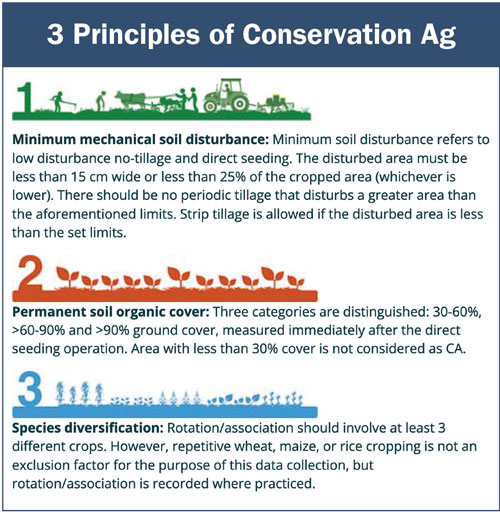
The global community tends to use the broader term of “Conservation Ag (CA)” when referring to no-tillage. These principles, which specify covered soils and crop rotations, are adapted to reflect the local conditions and needs. (FAO.org)
Conservation ag enables increased options for integration of diverse production sectors, such as crop-livestock integration and the integration of trees and pastures into agricultural landscapes. It also enhances biodiversity and natural biological processes above and below the soil surface, which contribute to increased water and nutrient use efficiency, and improved and sustained crop production.
Citation: FAO (2019). Conservation Agriculture. Available online at: http://www.fao.org/conservation-agriculture/overview/what-is-conservation-agriculture/en/ (accessed August 2019).
Expansion of No-Tillage Practice in Conservation Agriculture in Brazil
by R. Fuentes-Llanillo, T. Santos Telles, D. Soares Junior, T. Rodrigues de Melo, T. Friedrich and A. Kassam, 2021.
This article presents a recent review by another diverse international group of scientists to continue the rapid expansion and acceptance of conservation ag systems in Brazil. The exchange of ideas and concepts between Brazil and the European Union has mutually benefited both geographical areas.
No-till has been most widely implemented as one of the 3 fundamental ecological principles of conservation ag crucial for the sustainability of the nation’s agriculture. The authors demonstrate that the use of no-till as a single practice is no guarantee for sustainability, as biodiversity, technology transfer and adoption efforts are also required to reinforce the other two ecological principles of conservation ag, which are permanent soil mulch cover and crop diversification through rotations and/or associations.
Citation: Fuentes-Llanillo, Rafael, Tiago Santos Telles, Dimas Soares Junior, Thadeu Rodrigues de Melo, Theodor Friedrich, Amir Kassam. 2021. Expansion of no-tillage practice in conservation agriculture in Brazil. Soil and Tillage Research. Volume 208, 104877.
No-Till Farming Systems
by T. Goddard, M.A. Zoebisch, Y.T. Gan, W. Ellis, A. Watson and S. Sombatpanit, 2008.
This is a unique international book and a truly global collection of information presented by farmers, extension specialists, discipline professionals and research scientists. The World Assn. of Soil and Water Conservation had become aware of the range of no-till farming systems around the world and realized the need to share this information as widely as possible. The practice of no-till crop production has flourished during the last few decades and now is adopted in some form in most countries.
The pioneers of no-till have had a difficult time, led by innovative farmers skilled in practical problem solving and mechanics, and motivated to continually initiate new avenues of exploration. This book celebrates no-till and advances the concept by sharing the latest information and knowledge from around the world.
Citation: Goddard, T., M. A. Zoebisch, Y. T. Gan, W. Ellis, A. Watson, S. Sombatpanit. (Eds.). 2008. No-till Farming Systems. World Association of Soil and Water Conservation, Special Publication No. 3, Bangkok, TH: WASWC. pp 544.
Advances in Conservation Agriculture
by A. Kassam, 2020/2021.
This 3-book volume represents the most recent and comprehensive review of all aspects of conservation ag with a huge list of diverse scientists reflecting a true global perspective. Professor Amir Kassam is eminently qualified in all aspects of conservation ag and his leadership in collaborating with hundreds of other scientists has resulted in these scholarly books on the practice.
The books embrace the need for conservation ag; global developments; soil health and landscape management; the roles of minimum soil disturbance, mulch and cover crops; crops and cropping systems biodiversity; vegetable and perennial systems; integration of cropping and livestock; equipment development and mechanization; blended into institutional and policy support.
The series cover all aspects of soil health that addresses including weeds, insect pest and disease, nutrient cycling, carbon cycling and storage, biodiversity, and climate change mitigation and adaption that benefits farmers and society with enhanced ecosystem services and the rehabilitation of degraded farmland. Each chapter is complete in itself with intellectual leads to other components of conservation ag systems.
Citation: Kassam, A. H.(ed) 2020/2021. Advances in Conservation Agriculture. Volume 1: Systems and Science. 12 Chapters, pp 602; Volume 2: Practice and Benefits. 14 Chapters, pp 498.; Volume 3: Adoption and Spread. 17 chapters, pp 400. Cambridge, UK; Burleigh Dodds Science Publishing, Series 104.
Sustainable Soil Management is More Than What and How Crops are Grown
by A. Kassam, G. Basch, T. Friedrich, T.F. Shaxson, T. Goddard, T. Amado, B. Crabtree, L. Hongwen, I. Mello, M. Pisante and S. Mkomwa, 2013.
Soil management in agricultural landscapes should deploy production practices that are in harmony with nature, providing soil-mediated ecosystem functions if they are to deliver a broad range of ecosystem services (ES). Soil degradation in agricultural lands, its root causes and what solutions are being implemented in different parts of the world integrate improved soil management into sustainable farming and landscape management.
Four categories of ecosystem services are recognized; provisioning, regulating, cultural and supporting and are all included in conservation ag systems. The overall conclusion is that sustainable soil management as a basis for sustainable agricultural production is essential and practicable, but depends on both how and what crops are grown, as well as on the engagement of all stakeholders who are aligned toward transforming the unsustainable tillage-based farming systems to conservation ag systems.
Regardless of soil, climate and farmers’ economic capacity to invest, it is possible to develop a sustainable production system based on how and what crops are grown, while always following conservation ag principles.
Citation: Kassam, A., Basch, G., Friedrich, T., Shaxson, T. F., Goddard, T., Amado, T., Crabtree, B., Hongwen, L., Mello, I., Pisante, M., and Mkomwa, S. (2013). Sustainable soil management is more than what and how crops are grown. In R. Lal and Stewart, R. A. (Eds.), Principles of Soil Management in Agro-ecosystems. 2012. Advances in Soil Science. CRC Press.
Improving China’s Food and Environmental Security with Conservation Agriculture
by H.W. Li, J. He, Z.P. Bharucha, R. Lal and J. Pretty, 2016.
China has achieved impressive increases in agricultural output in recent decades. Yet approaches centered on increasing use of fertilizers, pesticides, fuel and water are not likely to achieve the required increases in food production by mid-century. In this review, the authors show that efficiencies of production are falling while the costs of environmental degradation are increasing.
Innovations that improve and conserve natural capital are urgently needed in the form of conservation ag offering promising prospects of both enhanced yields, soil organic carbon and environmental services when compared with traditional tillage. Key priorities for the spread of conservation ag as a sustainable form of agriculture are becoming a national policy with financial support, better coordination across agencies and better extension training for farmers.
Citation: Li, H.W., He, J., Bharucha, Z.P., Lal, R., Pretty, J. 2016. Improving China's food and environmental security with conservation agriculture. International Journal of Agricultural Sustainability. 14(4):377-391.
The Transformation of Agriculture in Argentina through Soil Conservation
by R. Peiretti and J. Dumanski, 2014.
The adoption of no-till in Argentina was a major turning point in the transformation of agriculture, initially led by innovative farmers like the senior author. Previously, soil erosion was so extreme and pervasive as to threaten the economic viability and survival of the industry. Today, with the majority of production under no-till, Argentina produces more than ever.
The authors describe the process of adoption of no-till and its impacts on agricultural production. They illustrate how, after first focusing on technology adoption of no-till, the system in Argentina has now broadened to include the concepts of CA and sustainable land management. These strategic moves have contributed to an ag industry in Argentina that is more economically and environmentally sustainable than in the past.
Citation: Peiretti, R. and Dumanski, J. 2014. The transformation of agriculture in Argentina through soil conservation. International Soil and Water Conservation Research 1(2): 14-20.
Organic Matter Dynamics and Carbon Sequestration Rates for a Tillage Chronosequence in a Brazilian Oxisol
by J.C.D. Sá, C.C. Cerri, W.A. Dick, R. Lal, S.P. Venske, M.C. Piccolo and B.E. Feigl, 2001.
Before this work, little quantitative information was available on amounts and rates of carbon (C) storage under no-till for the major ecological regions of Brazil. The amounts and rates of C storage were assessed under an innovative plow and NT chronosequence of 6 treatments. No-till, compared with the native field treatment, caused a significant increase in soil organic C (SOC) storage with 60% of this increase in the 0-10-centimeter soil layer.
There was a decrease in the amount of SOC in the 22-year conventional tillage treatment compared with the native field treatment, and 97% of this loss also occurred in the 0-10-centimeter layer. There was a close relationship between the SOC content and the amount of crop biomass input with increased SOC concentrations in the finer particle-size fractions of NT surface soil. The C storage rate for no-till varied with sampling depth — consistently more than the conventional tillage treatment.
Citation: Sá, J.C.D., Cerri, C.C., Dick, W.A., Lal, R., Venske, S.P., Piccolo, M.C. & Feigl, B.E. 2001. Organic matter dynamics and carbon sequestration rates for a tillage chrono sequence in a Brazilian Oxisol. Soil Science Society of America Journal, 65(5): 1486-1499.
No-Till Farmer invites your own personal commentaries, as well as feedback and works to consider in future editions of these lists, in the comment box at the end of this document. Our editors intend to use the process established in the fall of 2021 to update and expand this recognition project to include additional (and newer) research and works released that are influential in advancing no-tillage and conservation ag.
Related Content:
[Podcast] Great No-Till Research with Don Reicosky and Randall Reeder
In September of 2021, No-Till Farmer commissioned a project to determine the most significant research and publications that assisted in the understanding, and adoption, of no-till agriculture. In this episode of the No-Till Farmer Influencers & Innovators podcast, brought to you by Terrasym, Frank Lessiter talks with Randall Reeder, retired ag engineer from Ohio State University and Don Reicosky, retired USDA soil scientist about their collaborated on the detailed process to complete the large and aggressive project in advance of three important no-till milestones in 2022.
The 2024 No-Till History Series is supported by Calmer Corn Heads. For more historical content, including video and multimedia, visit No-TillFarmer.com/HistorySeries.






Post a comment
Report Abusive Comment